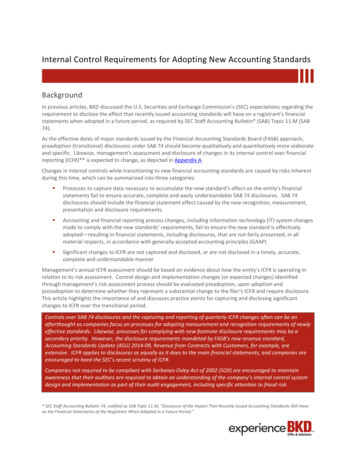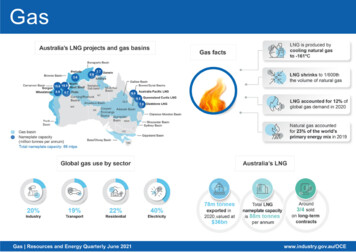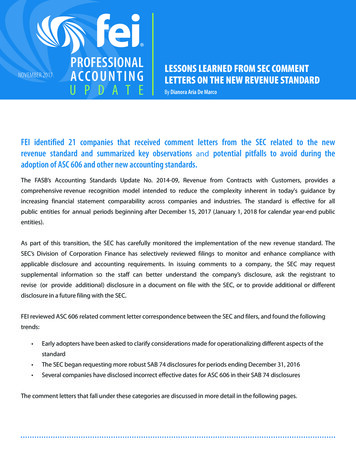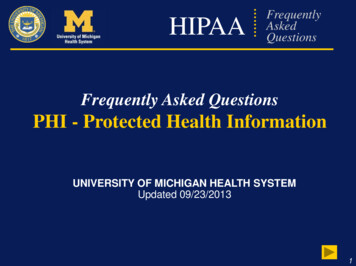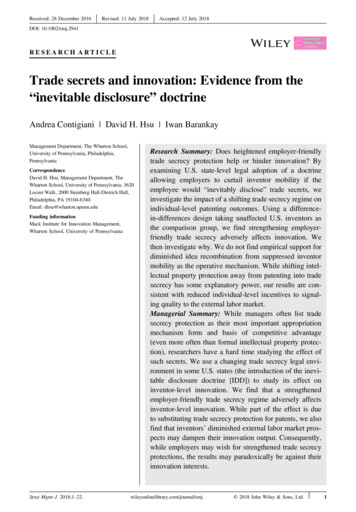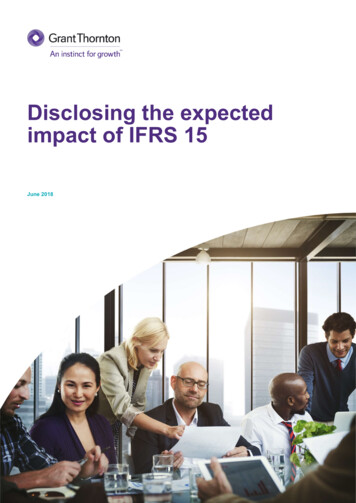
Transcription
Disclosing the expectedimpact of IFRS 15June 2018
Grant Thornton has reviewed 91 entities’ disclosures in relationto the anticipated impact of IFRS 15, highlighting key trends andthemes across various industries.We note that very few entities had decided to early adopt the new Standard with the majority choosing to implement it fromtheir first reporting period commencing on or after he effective date of 1 January 2018. Just under half of the entities reviewedhave not yet stated which method of transition they plan to apply. Of those that have disclosed their intended transitionmethod, more than half have opted for the modified retrospective approach (cumulative adjustment to opening reserves of thecurrent year).In addition, the majority of entities have not yet quantified the expected impact that IFRS 15 will have in their disclosures. Forthose that have provided quantitative information of the impact of the new Standard, there is a fairly even split between thoseanticipating a material impact and those that do not.The FRC has signalled that they will be scrutinising disclosures made by companies in their financial statements prior toimplementing the Standard and in November 2017 they stated that they expect all entities to discuss and quantify the impactthat IFRS 15 will have in the last financial statements before the transition date. In our report, we have highlighted six entitiesthat we consider have presented the strongest disclosures. These entities have provided analysis specific to each of theirrevenue streams, detailing the treatment under the previous revenue standards and how this has changed under IFRS 15, aswell as quantifying these changes.Disclosing the expected impact of IFRS 15 1
ContentsExecutive summary . 3Research. 7What good looks like . 8Aerospace . 25Automotive . 34Building supplies . 36Business Services . 40Chemicals . 45Components . 47Consumer Products . 49Energy and Utilities . 51Engineering . 60Estate Agent and Property Management . 67Financial Services . 70FMCG . 72Hotels . 74Leisure . 76Manufacturing . 78Marketing . 83Media . 85Mining and Resources . 90Non-Food Consumables . 95Oil and Gas . 97Online Food Delivery. 99Packaging . 101Pharmaceuticals. 103Property and Construction . 107Publisher . 114Recruitment . 116Retail . 123Sports Betting and Gaming . 128Support Services . 130Technology . 135Telecoms . 146Transport . 151Indices. 153Disclosing the expected impact of IFRS 15 2
Executive summaryIFRS 15 Revenue from Contracts with Customers is effective for annual periods beginning onor after 1 January 2018. It establishes a 5-step model for recognising revenue arising fromcontracts with customers.The new revenue Standard supersedes all currentrevenue recognition requirements under IFRS and isexpected to have a significant impact on companies’financial reporting.We have conducted a review of the public disclosuresmade by 91 companies across a number of industriesincluding telecoms, utilities, construction, retail andrecruitment to identify common themes arising as entitiestransition to, or begin to assess the impacts of, IFRS 15.We have primarily focused on the disclosures thesecompanies have made in accordance with therequirements of IAS 8 in their latest Annual Reports,however this review also includes other sources such asPress Releases where these cover points of interest.Early adoptionOf the 91 companies researched, only four have earlyadopted the Standard and one has stated an intention toearly adopt IFRS 15. The remaining companies havechosen to adopt the new Standard in line with the effectivedate.Transition approachesWhen the standard is adopted, an entity can choosewhether to apply the full retrospective approach (restatingprior year figures), or a modified retrospective application(recording an adjustment to opening reserves). Themajority of companies reviewed have stated their intentionto follow the modified retrospective approach.Of the early adopters, two companies applied the fullretrospective approach; these two companies recorded areduction in revenue, with one recording a decrease of 5%and the other, a more substantial decrease of 20%,compared to the previous standard.The other two early adopters have elected to use themodified retrospective application and they have recordedan increase in revenue, ranging from 6% to 15% ofrevenue recorded under the previous standard.Early adopters – Transition approachAdoption of IFRS adoptedNot earlyadopted50%95%Of the companies reviewed which are not planning to earlyadopt the Standard, 48% have yet to outline whichtransition method they intend to apply. 23% (twentyentities) of those that have stated their intention havechosen the full retrospective approach, with the remainderselecting the modified retrospective approach.Disclosing the expected impact of IFRS 15 3
Not yet adopted – Transition approachconsider that the transition will have a material impact buthave yet to quantify it.Not yet adopted – Anticipated 8%Not stated29%6050403020100QuantifiedIAS 8 disclosuresIFRS 8.30-31 requires an entity to disclose known orreasonably estimable information to enable users tounderstand the possible impact of a new standard. If anentity does not have reasonable information to be able tomake a detailed assessment, this fact must be stated. Thiswas a point raised in the FRC’s 2017 Annual Review ofCorporate Reporting; the FRC expect to see detaileddisclosures regarding the effect of IFRS 15, applying themspecifically to the circumstances of the entity. Andspecifically they stated that they expect entities to havequantified the impact of IFRS 15 in the last set of financialstatements before the transition date. It remains to beseen what level of challenge the FRC will raise in respectof those companies which it considers fall short of theseexpectations.However, only 24 entities who have not early adoptedhave quantified the anticipated impact of transition; justover half of these entities have anticipated that thetransition adjustments are likely not to be material at lessthan 1% of original revenue.The remaining entities (62) have yet to quantify theexpected impact of IFRS 15 with nine having yet todisclose an assessment in their financial statements at all.Of those who have made an initial assessment but notquantified an impact, (53 out of 62 non-early adopters),83% are not anticipating a material impact. The remainderMaterialNot quantifiedNot materialNot statedOther insightsWith revenue and profits, and consequently distributablereserves affected, there is likely to be an impact ondividends paid by companies. However only two of thecompanies reviewed discussed their dividend policy; onewill delay paying a dividend again until the next financialyear when it is expected that sufficient distributablereserves will have been created. The other company hasstated its intention to maintain a flat dividend, with no riseexpected until the next financial year.Bank covenants are also an area for companies toconsider when transitioning to IFRS 15. Two of the earlyadopters explain that agreements have been reached withlenders with regards to covenants, either by testing thecovenants as if IFRS 15 had not been adopted (‘frozenGAAP’), or by updating the covenants to reflect thechanges under IFRS 15. In both cases the entities hadapplied the full retrospective approach, but their lendershave not required retesting of the previous years’covenants.A quarter of the entities covered by our review have madereference to the disclosure requirements under IFRS 15and how these are different to the previous accountingstandards. A number of entities have highlighted these ascausing the main differences in the transition to IFRS 15.Disclosing the expected impact of IFRS 15 4
Industry analysisFrom the disclosures we reviewed, the industry that is most vocal about expecting significantchanges is telecommunications.The requirement to account separately for ‘distinct’ performance obligations within their contracts with customers, thatgenerally tend to comprise a bundle of goods and services, is likely to result in different treatments under IFRS 15 compared toIAS 18. In most cases, companies are saying that this is expected to lead to an acceleration of revenue recognised forequipment, but a reduction of revenue recognised for airtime, services etc.For most other industries, it is difficult to draw meaningful conclusions, as many companies are yet to determine the fullpotential impact of IFRS 15, and the extent of the impact experienced will be highly dependent on the specific terms of thecontracts that entities have with their customers.Some early themes that we have noted, however, are:01Within the recruitment industry, all entities reviewed are anticipating material changes, with the ‘early adopter’that we reviewed recording a decrease in revenue of 5%02Most property developers reviewed have not yet quantified the impact and for those that have made theassessment of the impact of IFRS 15, there is some evidence of differences in emerging practice. For exampletwo entities have outlined different treatments for part exchange sales03Entities in the engineering industry are expecting material changes however whether this results in theacceleration or deceleration of revenue will be very dependent on the specific contracts each entity has. Mostentities reviewed are planning to adopt the full retrospective transition approach04Entities who provide business services have highlighted key areas of consideration as principal vs agent, salescommission treatment and the capitalisation of costs incurred in securing contracts05For the mining industry, both entities’ disclosures that we reviewed noted that there would be no materialadjustments in the transition to IFRS 1506All pharmaceutical entities reviewed are looking to adopt the modified transition approach but are not anticipatingmaterial changes in the implementation of IFRS 1507For the most part, manufacturing entities and retail entities did not have very strong disclosures with regards tothe impact of IFRS 15, perhaps reflecting that they are anticipating very little change from IAS 1808Entities in the hotel industry were consistent in the main areas of focus for IFRS 15 transition, specifically beingprincipal vs agent considerations. They are also consistent in their choice of transition approach, being fullretrospectiveDisclosing the expected impact of IFRS 15 5
What good looks likeWe have highlighted six entities that we consider have presented particularly strong disclosures around IFRS 15implementation. These disclosures are detailed and tailored specifically to the businesses. They also include discussion ofeach revenue stream the entity has as well as explaining the previous treatment and the new treatment under IFRS 15.CompanyYear endSectorChemringGroup plc30/04/2017Defence &SecurityPageGroup plc31/12/2016Rolls Royce plcEarlyTransitionadoption approachModifiedYesretrospectiveYesPage 9Recruitment NoFullNotretrospective establishedNoPage 1131/12/2017Engineering NoFullYesretrospectiveYesPage 13IHG plc31/12/2017HotelsNoFullYesretrospectiveYesPage 18Orange plc31/12/2017TelecomsNoFullYesretrospectiveNoPage 20Technology NoFullYesretrospectiveYesPage n Quantified:Not quantified: Disclosureof impactMaterial change Material change cross referenceThe following Research and Sources section presents our full research, comprising extracts fromthe Annual Reports and other sources reviewed, grouped by industry sector. The full list of theentities that we reviewed is included in the Index (page 155-8).Disclosing the expected impact of IFRS 15 6
Research and sourcesDisclosing the expected impact of IFRS 15 7
What good looks likeDisclosing the expected impact of IFRS 15 8
Chemring Group plcChemring Group plc is engaged in offering solutions to protectdefence and security markets.The Company operates through three segments:1Countermeasures – development and manufacture of expendablecountermeasures for air, sea and land platforms, and land-based electronicwarfare equipment2Sensors & Electronics – development and manufacture of improvised explosivedevice (IED) detection equipment, chemical and biological threat detectionequipment, IED electronic countermeasures, network protection technologies andexplosive ordnance disposal equipment3Energetic Systems – development, procurement and manufacture of signalsand illumination devices and payloads, cartridge/propellant actuated devices,pyrotechnic devices for satellite launch and deployment, missile and ammunitioncomponents, propellants, warheads, fuses, separation sub-systems, actuatorsand energetic materials.What we liked: Chemringhas early adopted IFRS 15 as theyconsider it to be a more prudentrecognition basis for revenue. Weconsider this to be a strongdisclosure as Chemring discusseseach business division individually,disclosing the impact on revenue andoperating profit for each. Thedisclosure also states that underIFRS 15 revenue is recognised later,and it provides an appropriateexplanation for this.Adoption of IFRS 15 Revenue from Contracts with CustomersThe Group has adopted IFRS 15 for its 2017 financial year and the Board believes that this represents a move to a moreprudent basis of revenue recognition.The majority of the Group’s transactions are unaffected by IFRS 15, however when IFRS 15 is applied to a small number ofcustomer contracts this leads to a difference in the timing of recognising revenue. As permitted by the standard, the Group hasadopted the modified transitional provisions and as such the 2016 results remain as previously reported.The net effect of the adoption of IFRS 15 on the Group results for the first half of 2017 was broadly neutral. The impact ofadoption on the six month period to 30 April 2017 has been to increase revenue by 14.3 million and increase underlyingoperating profit by 4.1 million arising from transactions recognised in prior periods which would have subsequently beenrecognised in the current period under IFRS 15. Similarly a number of transactions, with a broadly equivalent operating profitimpact, will be recognised in the second half of 2017 that could have previously been recognised in the first half. This timingdifference is expected to recur at each reporting period end, albeit at a different quantum.The Group has adopted IFRS 15 for its 2017 financial year. The majority of the Group’s transactions are unaffected byIFRS 15, however when IFRS 15 is applied to a small number of customer contracts this leads to a difference in the timing ofrecognising revenue. As permitted by the standard, the Group has taken advantage of the modified transitional provisions andas such the 2016 results remain as previously reported. Under the modified approach the cumulative approach of initiallyapplying the standard is recognised at 1 November 2016 with no restatement of prior periods.An adjustment to brought forward retained earnings of 10.2 million has been recognised in the Condensed ConsolidatedStatement of Changes in Equity, representing the reversal of certain revenue that met the criteria for revenue recognitionunder previously applicable accounting standards but does not do so under IFRS 15.This also reduced receivables andpayables but increased inventory as at 1 November 2016.Disclosing the expected impact of IFRS 15 9
The impact of adoption in the period to 30 April 2017 can be seen below and arises from revenue recognised in prior periodswhich would instead have been deferred to the current period under IFRS 15. mPre IFRS 15IFRS 15 adjustmentAs reportedContinuing operationsRevenue235.314.3249.6Operating profit13.14.117.2Finance expense(5.9)‐(5.9)Profit before tax7.204.111.3Tax charge(1.5)(0.9)(2.4)5.73.28.9Profit after taxIn addition, a number of transactions, with a broadly equivalent operating profit impact, will now be recognised in the secondhalf of 2017 that could have previously been recognised in the first half. This timing difference is expected to recur at eachreporting period end, albeit at a different quantum.The adoption of IFRS 15 had the effect of increasing operating profit by 0.7 million in Countermeasures, increasing revenueby 1.0 million and operating profit by 0.5 million in Sensors and increasing revenue by 13.3 million and operating profit by 2.9 million in Energetics.The affected contracts are a combination of contracts for the provision of products. The significant risks and rewards ofownership had transferred but there remained an element of control, typically an undertaking to arrange elements of shippingon behalf of the customer, and hence the timing of revenue recognition is later under IFRS 15.Under IFRS 15 revenue is recognised on the basis of completion of performance obligations. This is typically determinedthrough a consideration of customer acceptance testing, contract terms arrangements. Typical payment terms may include aninitial deposit, with further receipts based on acceptance and delivery in accordance with the contract.Disclosing the expected impact of IFRS 15 10
Page Group plcPage Group provides recruitment services across three brandsand levels; Page Executive (executive recruitment), MichaelPage (qualified professional level) and Page Professional(clerical level).The Company specialises in the recruitment of qualified professionals across variousdisciplines.What we liked: Page Groupanticipates applying IFRS 15 fromthe relevant transition date, utilisingthe full retrospective approach. Thedisclosure presented discusses eachrevenue stream individually, statingthe current revenue recognitionpolicy and how this will change underIFRS 15. Page Group also providesan estimate for the quantum ofpotential transition adjustments foreach revenue stream. From thedisclosure, it appears that the Grouphas been proactive in preparing forIFRS 15; looking to implement newsystems, controls and processes toensure compliance with theStandard.IFRS 15IFRS 15 was issued in May 2014 and establishes a 5-step model to account forrevenue arising from contracts with customers. Under IFRS 15, revenue isrecognised at an amount that reflects the consideration to which an entity expects tobe entitled in exchange for transferring goods or services to a customer.The new revenue standard will supersede all current revenue recognitionrequirements under IFRS. Either a full retrospective application or a modifiedretrospective application is required for annual periods beginning on or after 1January 2018. Early adoption is permitted. It is the Group’s current plan to adopt thenew standard on the required effective date using the full retrospective method.The Group is in the business of providing recruitment services. IFRS 15 requiresrevenue to be recognised once value has been received by the customer and whenthe performance obligations have been satisfied. IFRS 15 also prohibits therecognition of up-front fees.During 2016, the Group performed a preliminary assessment of IFRS 15, which issubject to changes arising from a more detailed ongoing analysis. As a result of this preliminary assessment we do not expectany adjustment to be material being less than 1 million. Further detail is included below.In preparing to transition to IFRS 15, the Group is considering the following:Revenue earned on a contingent basis (c. 26% of revenue)Currently revenue recognised from permanent placements on a contingent basis is typically based on a percentage of thecandidate’s remuneration package, this income being recognised at the date an offer is accepted by a candidate and where astart date has been determined. It includes revenue anticipated, but not invoiced, at the balance sheet date, which iscorrespondingly accrued on the balance sheet within accrued income. A provision is made against accrued income forpossible cancellations of placements prior to, or shortly after, the commencement of employment. Our current view is that thisbasis of revenue recognition remains appropriate as our only performance obligation (the placement of the candidate) hasbeen performed. We therefore do not expect any adjustment as a result of the transition to IFRS 15 of revenue earned on acontingent basis.Revenue earned on a retained basis (c. 9% of revenue)Currently revenue recognised from permanent placements on a retained basis is typically based on a percentage ofcandidate’s remuneration package, this income being recognised on the completion of defined stages of work. The definedstages are ‘Retainer’, ‘Shortlist’ and ‘Completion’.One area of contention is around the first stage, retainer revenue. As IFRS 15 effectively prohibits the recognition of upfrontfees as revenue, we need to be able to demonstrate that the client gets an element of value from this initial stage and if so,how much. As the client receives a retainer pack, information on the market, salary levels, potential candidate requirements,and production of job specifications at this first stage, there is therefore clearly an element of value. The value received by theclient in the latter two stages also needs to be defined and this, combined with the value received at the first stage, willdetermine the percentage of revenue which should be recognised in each of the three stages.It is therefore possible that the percentage of revenue recognised at each stage will differ following transition to IFRS 15.However, bearing in mind the relatively low percentage or retained revenue as a proportion of total revenue, combined with theadjustment only being required to retained revenue earned in the last few weeks of the year having to be deferred oranticipated (in turn offset by revenue coming into the start of the year being deferred or anticipated from an earlier period), wedo not expect any adjustment to be material with our current estimate being less than 1 million.Disclosing the expected impact of IFRS 15 11
Temporary revenue (c. 60% of revenue)Revenue from temporary placements, which represents amounts billed for the services of temporary staff, including the salarycost of these staff is recognised when the service has been provided. We do not anticipate any change as a result of thetransition to IFRS 15 for revenue earned from temporary placements.Other revenue (c.5% of revenue)Other revenue earned, principally advertising revenue representing amounts billed to clients for expenses incurred on theirbehalf, is recognised when the expense is incurred. We do not anticipate any change as a result of the transition to IFRS 15for revenue earned from temporary placements.Presentation and disclosure requirementsIFRS 15 also provides presentation and disclosure requirements, which are more detailed than under current IFRS and mayresult in an increase in the volume of disclosures required in the Group’s financial statements. IFRS requires an entity toprovide users of financial statements with comprehensive information about the nature, amount, timing and uncertainty ofrevenue and cash flows arising from the entity’s contracts with customers. The Group has already commenced a review of therequired disclosures, appropriate systems, internal controls, policies and procedures necessary to collect and disclose therequired information.Disclosing the expected impact of IFRS 15 12
Rolls Royce plcRolls Royce looks to pioneer cutting edge technologies thatdeliver the cleanest, safest and most competitive solution tomeet the planet’s power needs.Its key five businesses are: Civil Aerospace, a major manufacturer of aero engines;Defence Aerospace, manufacturer for military transport and patrol aircraft; PowerSystems, providing high speed reciprocating engines, propulsions systems andenergy solutions; Marine, manufacturing and servicing propulsion and handlingsolutions; and Nuclear, managing plant design, safety, manufacture and support.IFRS 15IFRS 15 provides a single, principles based 5-step model to be applied to all salescontracts. It is based on the transfer of control of goods and service to customersand replaces the separate models for goods, services and construction contractscurrently included in IAS 11 Construction Contracts and IAS 18 Revenue. Thereare three broad implications:What we liked: These extensivedisclosures explain the key areas ofjudgement and where the significantestimates arise in assessing theimpact of IFRS 15. The segmentalinformation has then been restatedto reflect this impact of IFRS 15 in aseparate note within the financialstatements.1linked accounting will cease to exist so all OE sales will be treated on the same basis2OE engine cash deficits will no longer be capitalised and recorded as contractual aftermarket rights, they will instead berecognised on delivery3revenue and profits for aftermarket services will be recognised on an activity basis as costs are incurred.The Group will adopt IFRS 15 on 1 January 2018 using the ‘full’ retrospective approach. The Group has undertaken significantanalysis on the impact of IFRS 15 and the most significant accounting judgements, estimates and policies are set out below.Work will continue during 2018 to review and refine policies and procedures required to implement IFRS 15. As a result it ispossible that there may be some changes to the impact reported.Key areas of judgement:Determining the timing of satisfaction of performance obligations: Where the performance obligation is the supply of goods (principally OE and spare parts) which is satisfied at the point intime that those goods are transferred to the customer, the Group will recognise revenue at that point in time The Group generates a significant proportion of its revenue and profit from aftermarket arrangements arising from the useof the installed OE. These aftermarket contracts, such as TotalCare and CorporateCare agreements in Civil Aerospace,cover a range of services and generally have contractual terms covering more than one year. Under these contracts, theGroup’s primary obligation is to maintain customers’ equipment in an operational condition and this is achieved byundertaking various activities, such as repair, overhaul and engine monitoring over the period of the contract. Revenue onthese contracts is recognised over the period of the contract and the measure of performance is a matter of judgement. Ingeneral, the Directors consider that the stage of performance of the contract is best measured by using the actual costsincurred to date compared to the estimated costs to complete the performance obligations The assessment of stage of completion is generally measured for each contract. However, in certain cases, such as forCorporateCare agreements where there are many contracts covering aftermarket services, ea
'lvforvlqj wkh h[shfwhg lpsdfw ri ,)56 ,)56 5hyhqxh iurp &rqwudfwv zlwk &xvwrphuv lv hiihfwlyh iru dqqx

